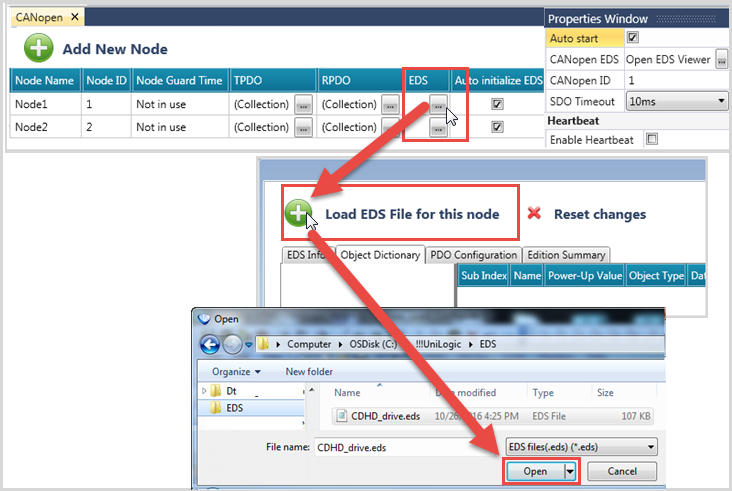
UniLogic provides a utility that enables you to import and view an EDS file, and use the EDS mapping to load data into the CANopen parameters.
To import a file, click EDS in a Node's row, click Load EDS file, navigate to the EDS file and click Open.
|
Note |
The EDS file is imported as is, without modifications. The EDS utility enables you to enter parameter data for the CANopen device according to the manufacturer's EDS file. |

UniLogic organizes and displays the EDS file in tabs:
|
EDS Info |
This is information provided by the device manufacturer, such as the Vendor Name.
|
|
Object Dictionary |
You can type in the search field to find a parameter.
Note that if a parameter read-only it is greyed out.
|
|
If the parameter is read/write, you can click the field and supply either a constant or a tag value. The following image shows an example of power-up values, which will then be downloaded as SDO.
|
|
|
PDO Configuration |
Click on the PDO Configuration tab, then select and RPDO or TRPDO from the left-hand column. Use the drop-downs to select the PDO mapping. |
|
|
|
|
|
Click on Create PDO Structs to add all of PDO mapping under Global Structs. |
|
|
|
|
|
Click on TPDO/RPDO collection to view the created PDOs. Click on More to view the CANopen addressing standard. |
|
|
|
|
Editing Summary |
Use the Editing Summary tab to view your modifications in the EDS utility.
|
Each power-up value configured in the Object dictionary will be downloaded to the device.
By default, SDOs are automatically sent when the PLC boots up; you can choose to change this by unchecking Auto-initialize EDS.

You can also send them at any time via Ladder.
Use these functions to initialize the device with the values that you have edited or entered via UniLogic's EDS utility. In your program, use the In Progress bits to condition the functions.
Init Node EDS
Use this function to initialize a specific node with the values edited or entered via UniLogic's EDS utility.
Init All Nodes EDS
Use this to initialize all of the CANopen nodes in your project with the values edited or entered via UniLogic's EDS utility.
Restore Node Defaults
If your CANopen device enables this function, which refers to object 1011 in the node's dictionary, you can use this to reset all of the node's addresses to the manufacturer's default values.
Note |
If Restore Node Defaults is included in the program, but is not supported by the device, UniLogic issues a compilation warning. |
The status of these functions and error messages are provided in the Node Data Struct.
